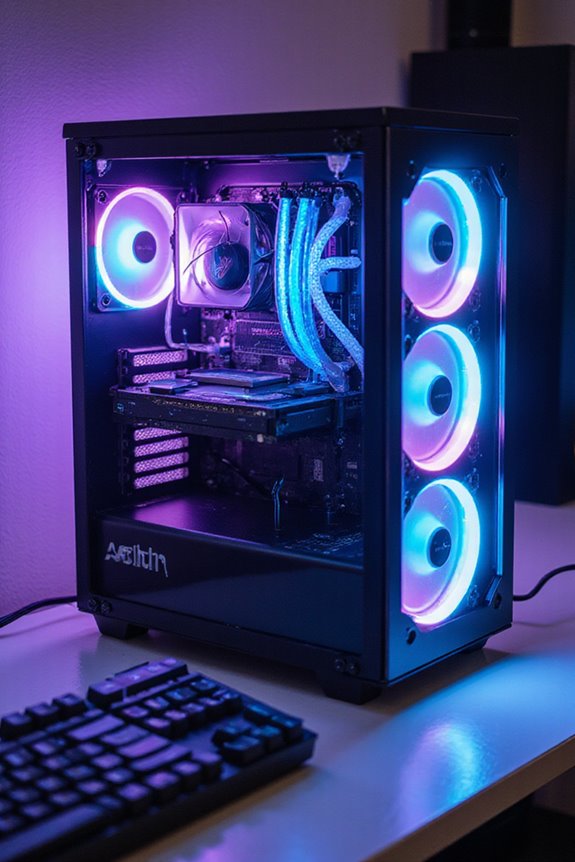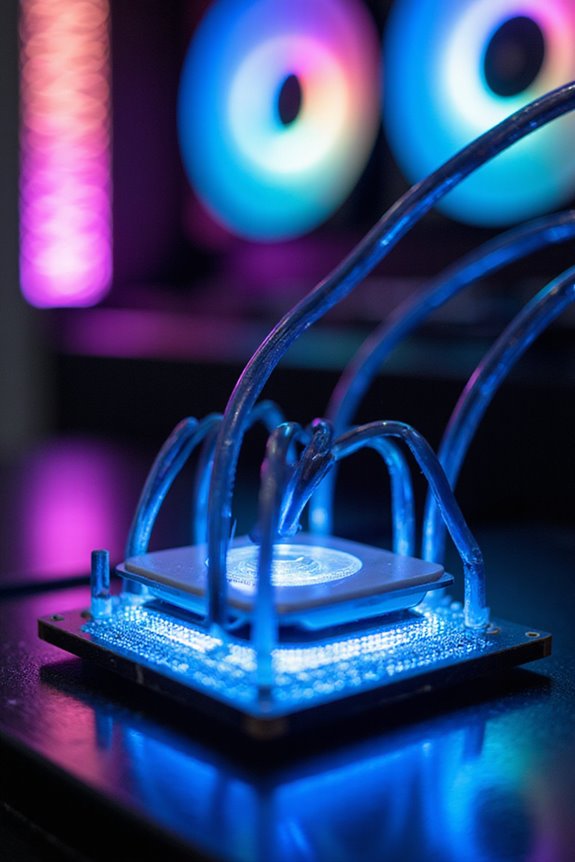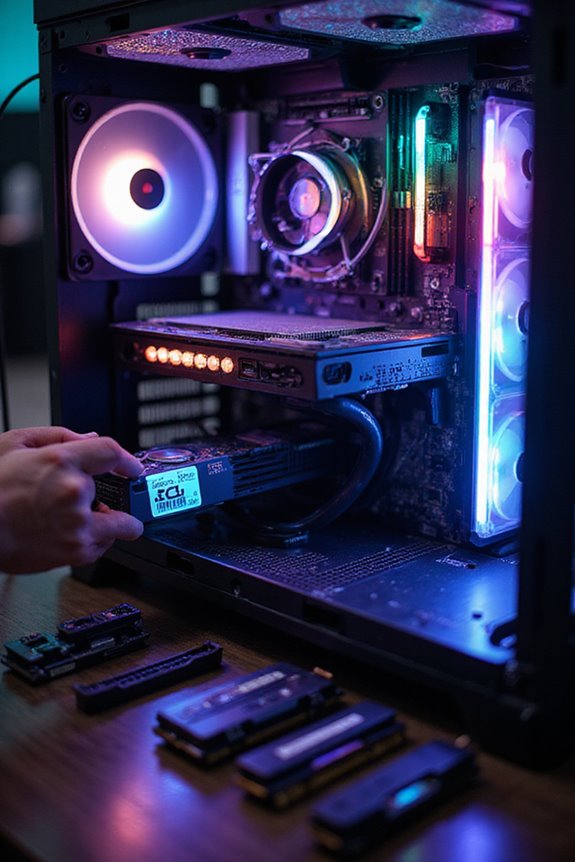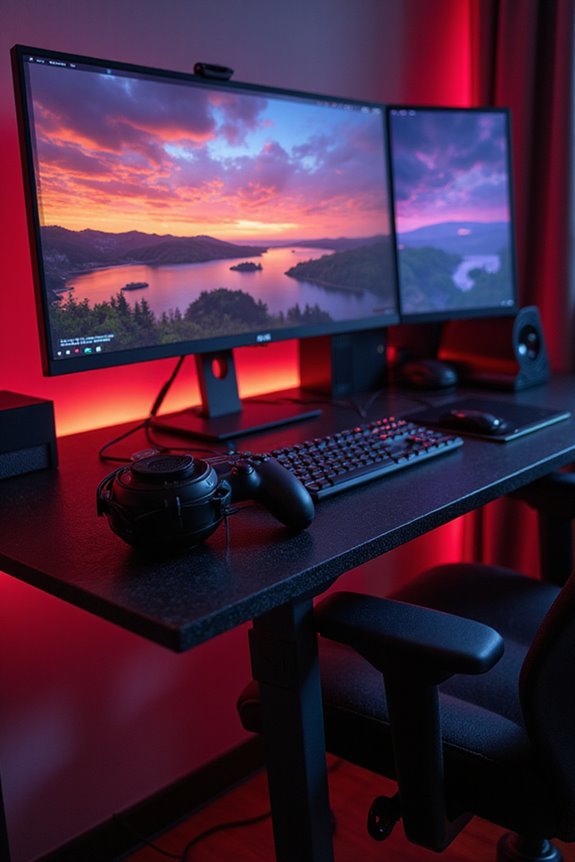To customize your gaming PC and make it unique, I start with the processor and graphics card. Choosing an AMD Ryzen 7 for balanced power or an RTX 5070 offers great performance. Upgrading RAM and switching to an SSD boosts speed and responsiveness. Don’t forget about power supplies—an 80 PLUS certified one guarantees reliability. Finally, a stylish case with RGB lighting adds flair. Want to design yours? There’s plenty more I can share on the details!
Key Takeaways
- Choose a unique case design, like the Corsair 4000X or Lian Li, to reflect your personal style and enhance aesthetics.
- Incorporate RGB lighting to create a cohesive visual theme that syncs with your components for a vibrant look.
- Select custom cooling solutions, such as liquid cooling, to not only improve performance but also add a sleek appearance.
- Use personalized cable management techniques to keep your setup organized and visually appealing while improving airflow.
- Opt for a neutral color scheme or bold colors that resonate with your personality, ensuring your gaming PC stands out.
Selecting the Right Processor for Your Needs
When it comes to selecting the right processor for your gaming PC, how do you choose among the countless options available? I’ve found that high-end choices like the AMD Ryzen 7 9800X3D deliver exceptional gaming performance without breaking the bank. If you want something with even more power, the Ryzen 9 9950X3D boasts 16 cores but comes with a higher price tag. For mid-range setups, the AMD Ryzen 7 7700X strikes a great balance between performance and cost. On a tighter budget, options like the Intel Core i5-13400F or AMD Ryzen 5 7600 offer solid entry-level performance. Just remember, your choice should align with your gaming needs, whether you’re diving into AAA titles or casual gaming.
Choosing the Perfect Graphics Card
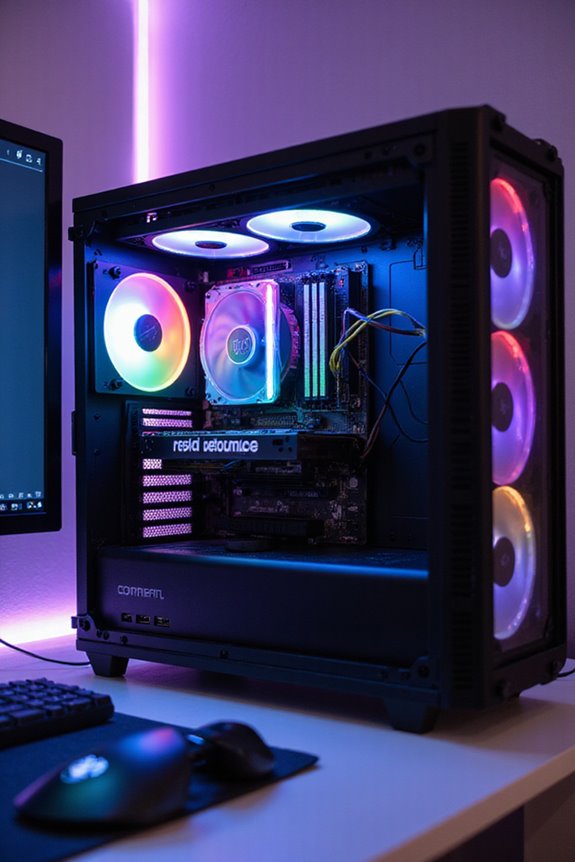
How do you choose the perfect graphics card for your gaming rig? First, consider what you’re after. If you want top-tier performance, the Nvidia GeForce RTX 5090 is a beast with 32GB GDDR7 memory, though it’ll hit your wallet hard at nearly $2000. For something that balances performance and cost, the RTX 5070 or AMD Radeon RX 7600 might be your best bet. If you’re on a budget, the Intel Arc B570 offers decent performance for around $220. Remember, look at CUDA cores or Stream Processors for efficiency, and keep an eye on power consumption—some models, like the RTX 5090, can drain up to 575W. Ultimately, your choice hinges on your gaming needs and budget.
Optimizing Memory and Storage Solutions

Optimizing your memory and storage solutions can make a noticeable difference in your gaming experience. Upgrading your RAM is a great start; more RAM means you can run more applications without slowdowns. I’ve also found that closing unnecessary background apps frees up significant RAM during gameplay.
Moving your games to an SSD can drastically improve loading times, making your gaming sessions smoother. Don’t forget about virtual memory—customizing its size can prevent stuttering, especially with limited RAM.
Regular system restarts are essential to clear memory cache, and cleaning up your disks keeps performance steady. It’s all about balance; the right tweaks guarantee you’re gaming without hiccups, letting you focus on what really matters: enjoying the game!
Enhancing Power and Cooling Systems
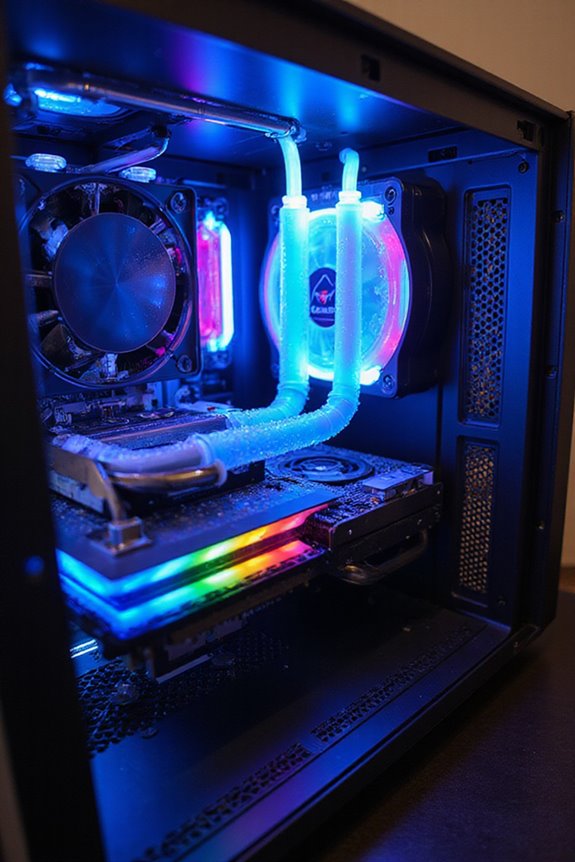
To enhance your gaming experience, focusing on power and cooling systems is just as important as upgrading your graphics card. A high-quality PSU, ideally with 80 PLUS certification, guarantees efficiency and reliability. I usually go for a modular option; it improves airflow and cable management, which can make a noticeable difference.
Don’t forget about future-proofing—choosing a PSU with PCIe Gen 5 support can save you headaches later. For cooling, consider liquid cooling systems; they offer superior performance, especially in overclocked setups. Be certain to monitor temperatures using software, adjusting settings as necessary. Good airflow is key, so keep your cables organized. After all, a cool system is a happy system, right?
Designing Your Case for Aesthetics and Functionality
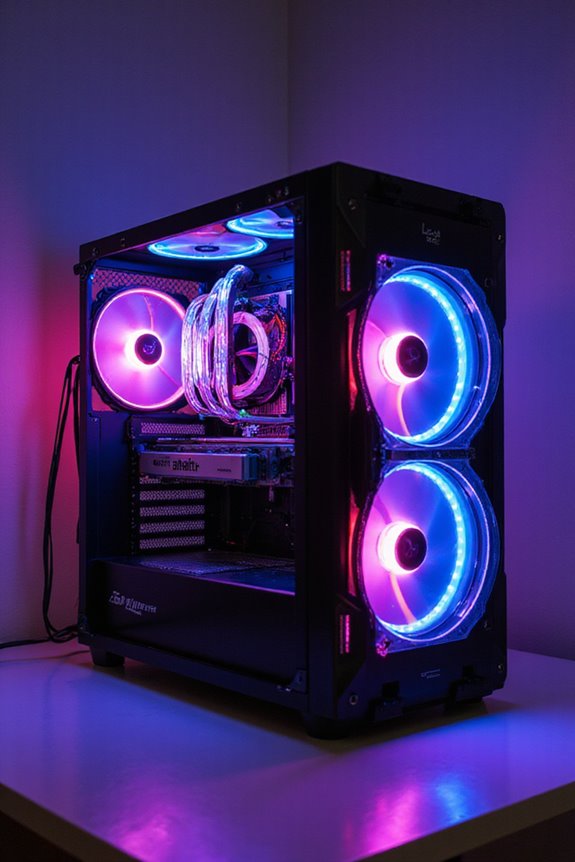
When it comes to designing your gaming PC case, striking the right balance between aesthetics and functionality is essential. I love how a neutral color scheme, like black or white, offers versatility, while bold colors like red or blue can really make a statement. Adding RGB lighting isn’t just about looks; it can sync with your other components for a cohesive vibe. Material matters, too—glass and metal not only look sleek but also provide durability. Don’t forget about cable management and cooling systems; both keep your setup tidy and efficient. Cases like the Corsair 4000X or Lian Li designs offer great options for personalization. Ultimately, your case should reflect your style while being practical, ensuring a smooth gaming experience. When selecting a gaming desk, consider options with built-in power strips for efficient power management and safety.
Exploring Customization Software and Features
Customizing your gaming experience isn’t just about the hardware; it’s also about the software that brings everything together. Tools like the OMEN Gaming Hub let you control RGB lighting, map macro keys, and manage fan speeds, giving you that extra edge during intense sessions. I love how Jack Core Skin adds customizable widgets, like a music visualizer and clock, making my desktop feel alive and personal. Windows customization tools are great for quick access to apps and information, enhancing efficiency. Plus, game launchers centralize my gaming library, complete with rewards systems. While there are endless options, finding the right balance between aesthetics and performance is key. After all, it’s all about making your gaming setup truly yours.
Incorporating RGB Lighting and Visual Effects
RGB lighting can truly elevate your gaming setup, transforming it from a simple workstation into an immersive environment. With endless color combinations, I can customize my PC to match the vibe of any game. It’s like having a personal light show that syncs with in-game events, enhancing the overall experience. Plus, it provides visual cues, like health indicators, right on my peripherals. But it’s not just about aesthetics. RGB components also help monitor temperatures, ensuring my system stays cool during intense gaming sessions. While I love the look, I appreciate the practicality, too. Just remember, too much lighting can be distracting. Balancing it all is key for a truly unique and functional setup. According to research, most RGB lighting systems can sync with games, providing an immersive experience that enhances gameplay.
Future-Proofing Your Gaming PC With Modular Design
As I dive deeper into the world of gaming PCs, I’ve realized that choosing a modular design can be a game changer. With user-replaceable components, I can upgrade my system without tossing everything out, which is both cost-effective and eco-friendly. It’s like having a PC that grows with me! The standardized interfaces make integrating new tech a breeze, ensuring my setup stays relevant for years. Plus, when repairs are needed, swapping out modules is quick and painless, reducing downtime. Though it might take a bit to find the right parts, the long-term savings and performance optimization are worth it. A modular design not only enhances my gaming experience but also aligns with my values of sustainability and responsible consumption.
Frequently Asked Questions
What Are the Benefits of Liquid Cooling Versus Air Cooling?
When choosing between liquid and air cooling, I find liquid cooling offers superior heat management, quieter operation, and aesthetic flexibility. It’s definitely worth considering if you want enhanced performance and a unique look for your setup.
How Can I Improve My Pc’s Airflow for Better Cooling?
Imagine your PC breathing easily, air flowing like a gentle breeze. I’ve found that adding quality fans, organizing cables, and ensuring unobstructed airflow greatly cools my system, keeping everything running smoothly and efficiently.
What Tools Can Help Me Monitor My Pc’s Performance?
When I want to monitor my PC’s performance, I rely on tools like HWInfo and MSI Afterburner. They give me real-time stats and insights, helping me guarantee everything’s running smoothly during my gaming sessions.
How Do I Know if My PSU Is Sufficient for Upgrades?
When I upgraded my graphics card, I felt like I was giving my PC a heart transplant. To guarantee it thrives, I calculate wattage needs, consider safety margins, and check for compatibility with my power supply.
Can I Mix Different Brands of RAM in My PC?
I’ve found I can mix different brands of RAM, but it’s risky. For the best performance, I’d recommend sticking to the same brand and specifications, ensuring everything runs smoothly together. Trust me, it’s worth it!

